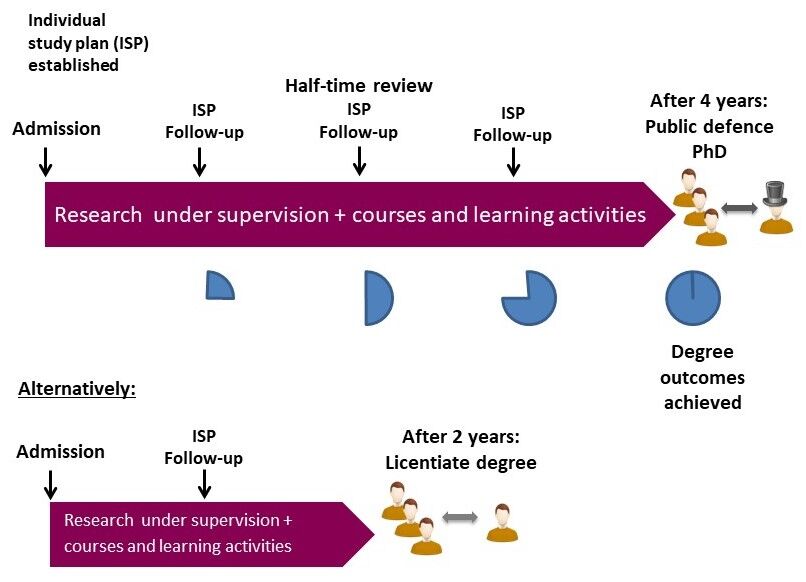The doctoral student´s learning, development and achievement of outcomes for degree
A doctoral education is a journey where the doctoral student acquires knowledge and develops skills by conducting research and participating in various learning activities. The progress of learning is regularly monitored and by the time the doctoral degree is awarded, the doctoral student should have achieved all the learning outcomes.
The doctoral learning journey
Everything the doctoral student does within their doctoral education involves learning and contributes to the development of knowledge, skills and judgment.
To clarify the learning process and the achievement of learning outcomes, there are the following steps at KI:
- Individual study plan (ISP): A plan for how the doctoral student will achieve the degree outcomes is formulated.
- Annual follow-up: Each year, the doctoral student and supervisor monitor the progress, document it in the ISP and plan the remaining education.
- Half-time review: The learning journey has reached the halfway point, and the doctoral student presents his/her progress in a half-time report.
- Public defence of thesis: Now all that remains is to tie the bag: In the report on the doctoral student's learning and development as a researcher including achievement of outcomes for degree (see below), the doctoral student and supervisor summarise the learning process, describe how the outcomes have been achieved and how the doctoral student has developed into an independent researcher.

At the thesis defence: Reports on learning and development and achieving the outcomes for degree
At the end of the learning journey, doctoral students shall reflect on and summarize their development, what they have learned during their doctoral studies and how they have achieved the learning outcomes.
In the same document, the principal supervisor provides an account of the doctoral student's development into an independent researcher.
A form has been developed to be used for these reports, see below. In it, the doctoral student and supervisor must also certify that they assess that the doctoral student will have achieved the degree outcomes at the time of the public thesis defence/licentiate seminar.
The purpose
The purpose of the report is to wrap-up the journey and provide an overall picture of the doctoral education. This becomes a complement to the results presented in the thesis kappa and in the papers and manuscripts, and constitutes a basis for the examining board and opponent as they prepare the public defence.
Note that the report is a self-reflection and not an examination paper, and can therefore neither be passed nor failed.
When, where, how?
1. Write a report
The doctoral student and the principal supervisor write their reports in the template/form and certify the doctoral student's achievement of outcomes (see Reports on the doctoral student´s learning and development as a researcher including achievement of outcomes for degree).
Doctoral student:
- Organise the text in the way that suits you best. Use your own words to describe your journey. One tip is to structure it according to the ten learning outcomes. (seven for licentiate). Keep in mind that even failures and setbacks may have contributed to learning.
- Focus not only on the thesis components and the courses you have taken, but also on other things you have done and experienced during these years that have contributed to your learning.
- If you have used the individual study plan as the intended tool, much is already written in the section Degree objectives.
- The mid-term report included a section called "Status report of progress" which is a good starting point.
- The doctoral student's report is recommended to cover about 2-3 pages.
Main supervisor:
- The supervisor and the doctoral student contribute with different perspectives. It is therefore good if the doctoral student and supervisor write their texts independently of each other, but it can be informative for both to see what the other has chosen to emphasise.
- The supervisor's report is recommended to cover about 1 page.
Note that this report was previously included in the form for the application for a public defence, but has now been moved to a separate document together with the doctoral student's report.
Support for writing: Read "How can the objectives of doctoral education be achieved?" on this page: Outcomes for doctoral education according to the Higher Education Ordinance | Staff Portal (ki.se).
2. Public defence application
The completed report form is submitted together with the application for public defence and constitutes "part 3".
Part 3 is not reviewed by the Dissertation committee but is submitted at this point to check that everyone has written a report. By collecting the reports, it is also possible to follow up how the procedure works and to draw lessons about doctoral students' learning at a university-wide level.
3. Send to the examination board and opponent
- The completed report form is sent to the examination board together with other documents for the preliminary review.
- The completed report form is sent to the opponent no later than when the printed thesis is sent to the opponent.
This constitutes a basis for the examination board and opponent as they prepare the public defence. Their task includes asking questions so that the doctoral student can show that they have achieved the degree outcomes.
4. Optional: Include in the thesis or the monograph
If the doctoral student so wishes, the doctoral student's report (but not the supervisor's) can be included in the thesis or the monograph as an appendix. The doctoral student may decide whether to publish the same version that was submitted to the examination board or whether the doctoral student wishes to work further on his/her report.
